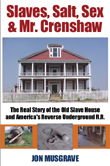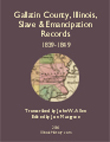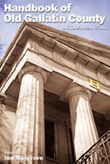 Slaves, Salt, Sex & Mr. Crenshaw
Slaves, Salt, Sex & Mr. CrenshawThe Real Story of the Old Slave House and America's Last Station on the Reverse Underground R.R.
 Gallatin County, Illinois, Slave & Emancipation Records, 1839-1849
Gallatin County, Illinois, Slave & Emancipation Records, 1839-1849John W. Allen's 1950 transcription of the now-missing second slave registry.
 Handbook of Old Gallatin County & Southeastern Illinois
Handbook of Old Gallatin County & Southeastern Illinois
The must-have book for any southeastern Illinois genealogist or researcher.

|
||
| Old Slave House / Reverse U.G.R.R. Station | Outside / Equality, Illinois | |
|
Excerpts from the Application National Park Service Abstract: The Old Slave House outside Equality, Illinois, is the last standing station on the Reverse U.G.R.R. Started by salt maker John Hart Crenshaw in 1838, the home's third floor attic contains 12 rooms long believed to be where Crenshaw operated a secret slave jail for kidnapped free black and captured runaway slaves. A grand jury indicted Crenshaw for kidnapping, once in the mid 1820s (the outcome unknown) and again in 1842 when a trial jury acquitted him. The case's victims, Maria Adams and her seven or eight children, ended up as slaves in Texas. In 1828, Crenshaw took Frank Granger and 15 others downriver to Tipton Co., Tennessee, and sold them as slaves. Crenshaw also kidnapped Lucinda and her children in 1828. She ended up in Barren Co., Kentucky. Contemporary letters identify Crenshaw's role back both cases. Crenshaw also kidnapped Peter White and three others in the 1840s. They were sold into slavery in Arkansas, but later rescued. Stories of strange noises upstairs coming from victims, date to 1851. Despite accounts that the rooms were slave quarters, Crenshaw family stories indicate a distinction between the plantation's household servants and field hands, and the victim's of Crenshaw's criminal activities. |
|||
| Application elements (links in PDF files)
The National Park Service is now taking comments on this application and whether the Old Slave House should be added as a kidnapping element of the Underground Railroad Network to Freedom program. Click the "taking comments" link to go to the NPS site to add your comment. When the new page opens, scroll down to the Illinois sites being nominated, find the Old Slave House and click the link to make a comment. For more on the Old Slave House click here. | |||
|
|
|||